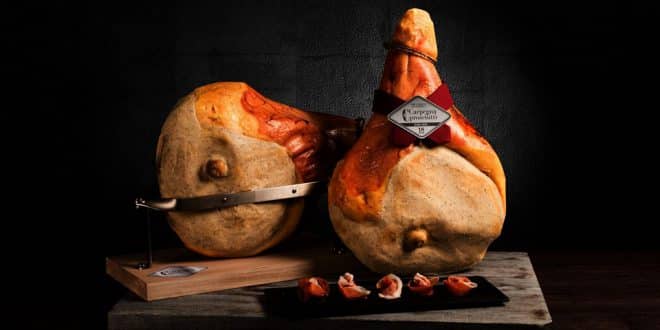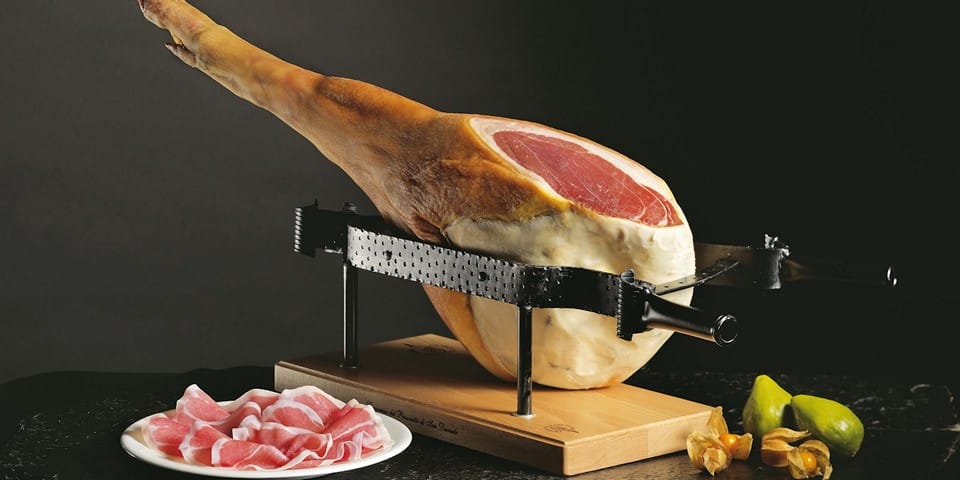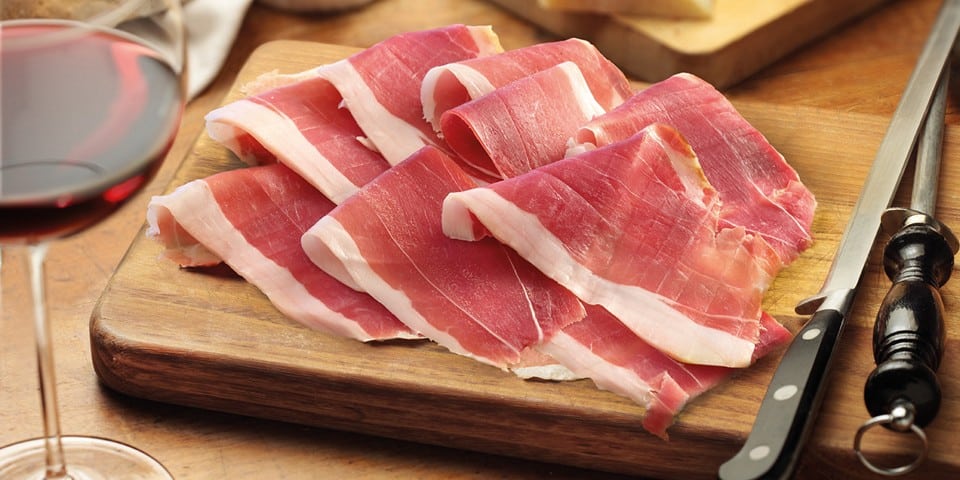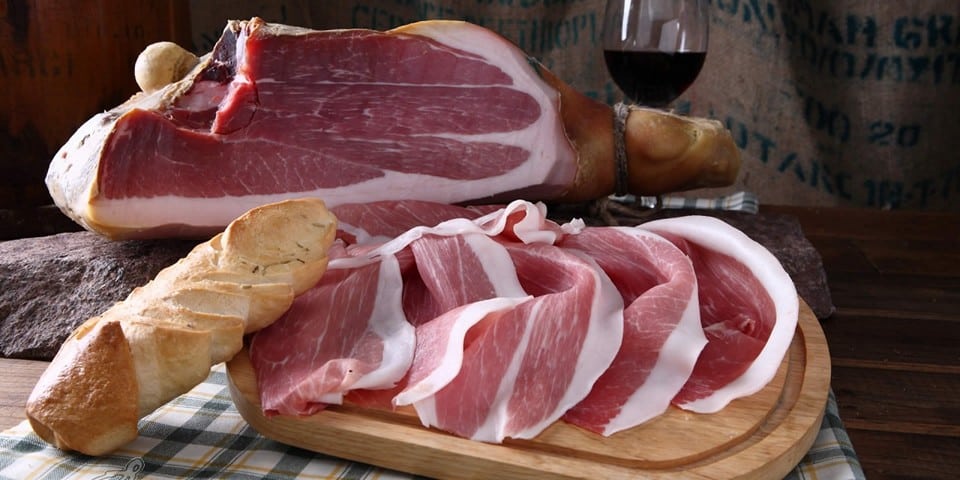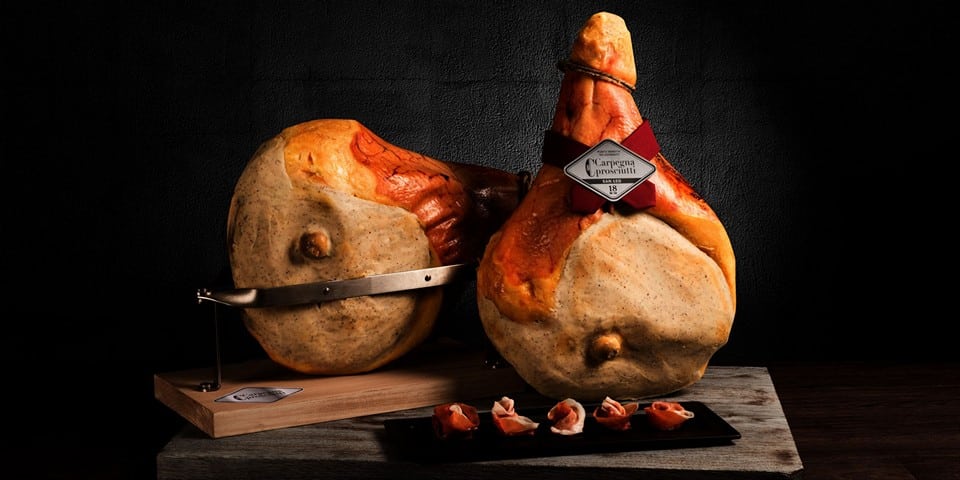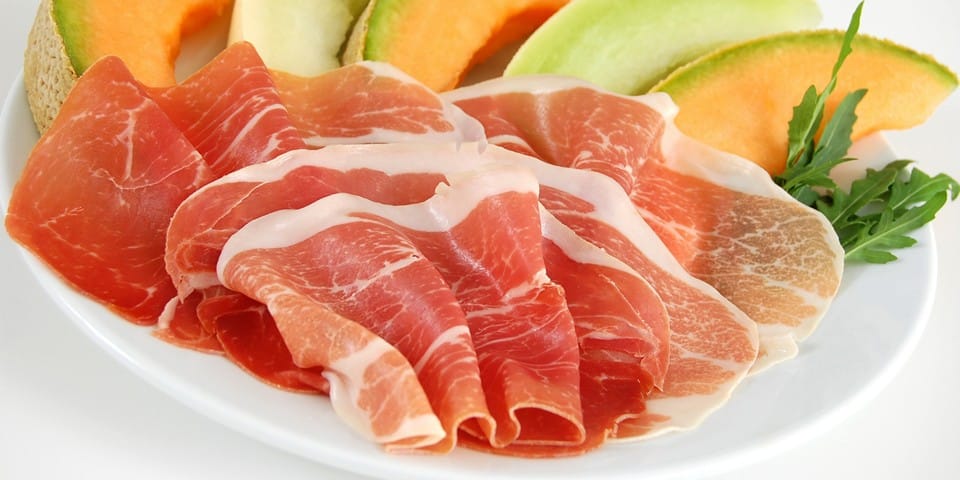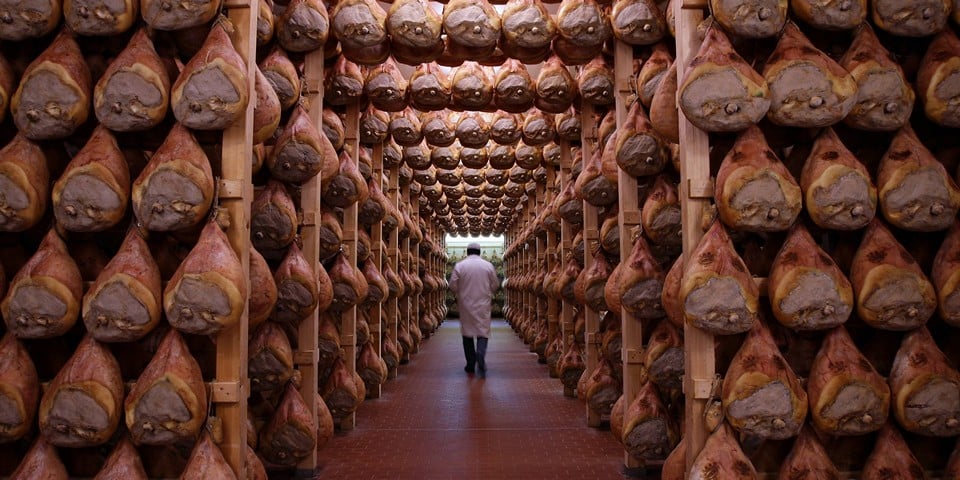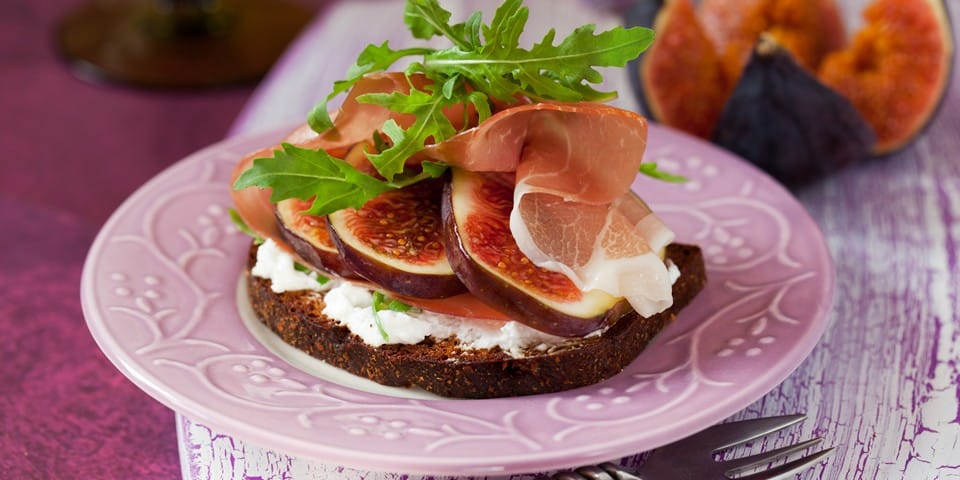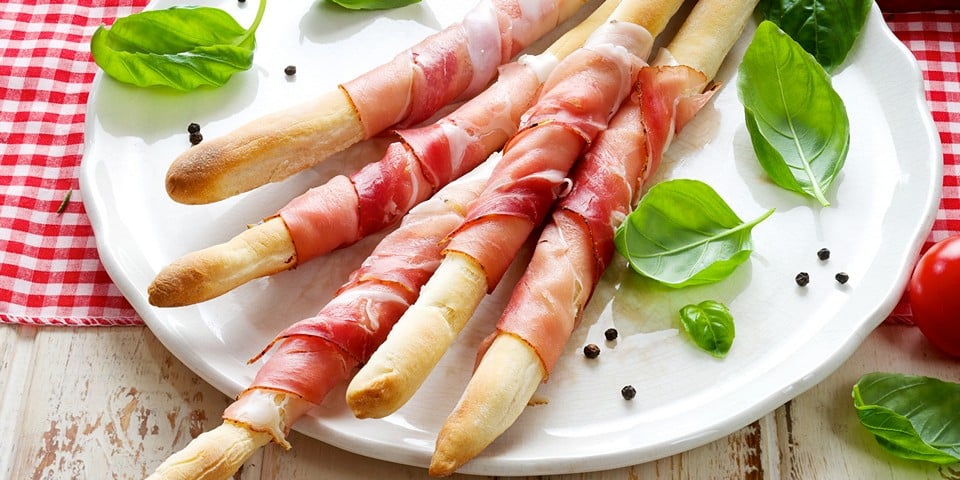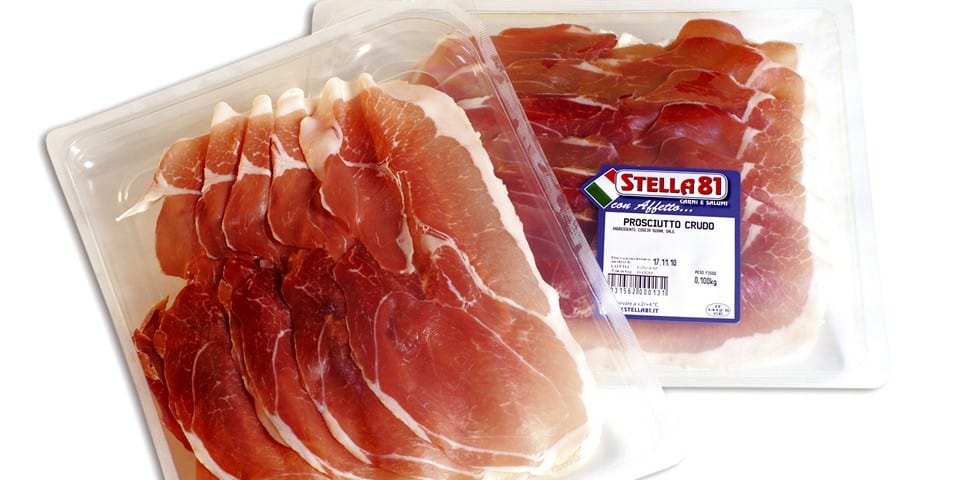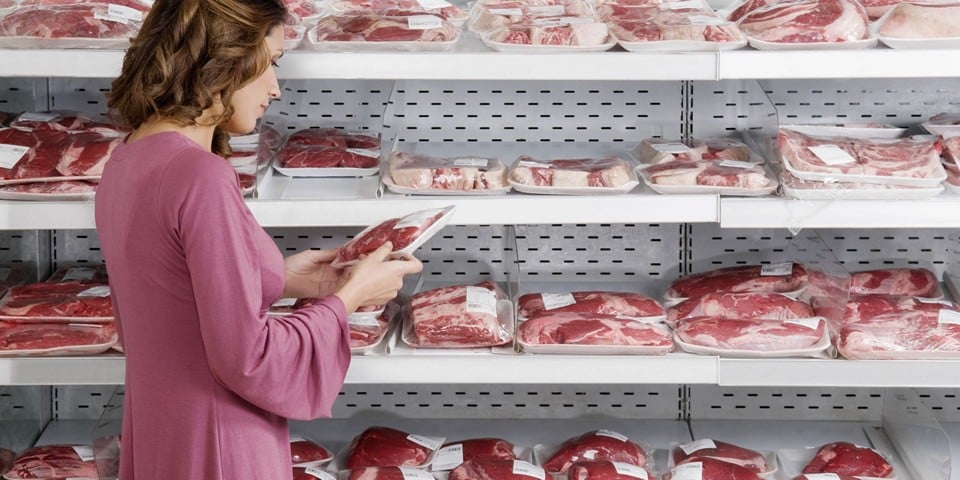Prosciutto is an Italian ham loved in many countries. However, it has nothing in common with the ham we traditionally see in local grocery stores.
Prosciutto is a dry-cured ham – it is sold as a whole piece of meat or sliced into ultra-thin slices. Adherence to traditional manufacturing processes and centuries-old history has allowed Italian ham to enter the ranks of DOP category products easily.
Page Contents
DOP Varieties
In Italy, there are seven varieties of prosciutto that belong to the category of products with a protected designation of origin. To understand the differences between all these options, let’s introduce you to each of them.
Prosciutto di Parma
Prosciutto di Parma is the most well-known variety of ham, produced exclusively in the Parma province. It is made from only two components: pork and salt. The use of other spices or preservatives is strictly forbidden.
Moreover, the pork used for Parma ham must never be frozen. The production process takes about a year. Once the quality is verified, the European Union Commission stamps it with a crown, which is the distinguishing mark of Prosciutto di Parma. Due to the natural aging process, the meat retains its natural red color. The taste of this ham is sweet, sophisticated, and intense.
Prosciutto di San Daniele
Prosciutto di San Daniele is a typical product from the town of San Daniele del Friuli. As Italians say, this ham comprises three components: pork, sea salt, and the area’s unique climate.
Furthermore, the overall production cycle of this recipe takes 13 months. The distinguishing feature of Prosciutto di San Daniele is the “hoof” on the pork leg, meaning the thigh is left “biologically intact”. The meat possesses a pink-red color with white veins of fat. The flavor is sweet and tender, with a sharp aftertaste.
Prosciutto di Modena
Prosciutto di Modena is a type of ham traditionally produced in the city of Modena. The unique combination of geographical factors in the production area gives this product an unmatched flavor.
The maturation period for this meat lasts approximately 14 months or less, depending on the size of the thigh. By the end of maturation, the leg weighs between 8-10 kg. The meat cut presents a bright red color. It offers a rich taste that isn’t salty and exudes a pleasant, sweet aroma.
Prosciutto Toscano
Prosciutto Toscano is a variety of ham from the Tuscany region (Toscana). The curing process for this meat involves not just salt, but also pepper and a blend of herbs like sage and rosemary.
The aging period lasts between 10 to 12 months, but some samples mature around one and a half years. The weight of the leg should be no less than 7.5 kg. The color ranges from bright to light red with a minor presence of white fat. The flavor is delicate with a hint of herbs.
Prosciutto Veneto Berico-Euganeo
Prosciutto Veneto Berico-Euganeo is a ham originating from the commune of Montagnana. It’s crafted from a pig’s leg with the addition of salt and spices.
A distinguishing mark of Prosciutto Veneto is a stamp in the form of a winged lion. At the end of preparation, the leg weighs between 8 to 9 kg after a minimum maturation period of 9 months. The meat color is typically pink, and it has a soft, sweet aroma.
Prosciutto di Carpegna
Prosciutto di Carpegna is a type of ham from the town of Carpegna.
The pork used for this ham is produced in three regions of Italy: Emilia-Romagna, Marche, and Lombardia. The maturation process of the salted legs takes at least 13 months. The final weight of the leg ranges from 8 to 11 kg. The cut has a salmon color. The taste is delicate, with a piercing aroma.
Prosciutto crudo di Cuneo
Prosciutto crudo di Cuneo is a product manufactured in the provinces of Cuneo, Asti, and the southern part of Torino.
The salting process is carried out using dry salt, which can contain pepper or other spices. The overall production process lasts a minimum of 10 months. The weight of the prepared leg ranges from 7 to 10 kg. The color of the cut is uniformly red, with a mature, sweet aroma.
In summary, the main distinctions among all the varieties are:
- Production territory
- Breed, age, and feed of the animals
- Spices used for salting and maturation time
These unique characteristics contribute to the distinctive taste of each ham. Despite the uniqueness of all types, Prosciutto di Parma enjoys particular global fame.
The History of Italian Prosciutto
The history of Italian prosciutto begins in the times of the Roman Empire, over 2000 years ago, where pork was the main food source for the residents of Parma. The production of Parma ham probably began when farmers started to harness the preservative properties of salt, following the discovery of the salt source in Salsomaggiore.
There are several theories about the origin of the word “prosciutto”. One of them suggests that it comes from the Parma dialect “pàr-sùt”, which means “always dry”. Another theory attributes it to the Latin phrase Perex Suctum, which translates to “drained” or “dried”.
As early as the 3rd century BC, Cato described the process of prosciutto production, which has reached our days almost unchanged. Over the centuries, many authors (Polybius, Strabo, Horace) mentioned ham in their works.
Hannibal, entering Parma after his victorious battle in 217 BC, was greeted with a festive banquet. Despite the devastation and poverty, the peasants brought out their salted meat, which was particularly appreciated by the general.
The French Gauls were evidently also familiar with Prosciutto di Parma. A butcher trading ham is depicted at the entrance to the Reims Cathedral in France.
Despite such distant roots, the mass production of prosciutto began only in the Middle Ages. It is mentioned in 14th-century documents, in 16th-century wedding menus, and by the turn of the 18th-19th centuries, ham was used as a staple food for sailors during the “cruiser war”.
In 1963, to protect the traditions and quality of their product, Parma producers established a consortium to supervise the production of ham. In 1996, the European Union included Prosciutto di Parma in the list of DOP (Denomination of Protected Origin) category products. This recognition ensures that only hams that meet strict regulations regarding their origin and production methods can bear the name Prosciutto di Parma.
Technological Recipe for Making Prosciutto
Prosciutto di Parma is a prerequisite for producing the entire process of preparation and processing of raw materials in the region and its surroundings. Pigs of two breeds, Large White Landrance and Duroc, are raised in 10 regions of central and northern Italy. Their diet consists of corn, barley, and whey leftover from Parmigiano production. The animals are ready to enter the production cycle when they reach 9 months of age and weigh 160 kilograms (approximately 352 pounds).
Raw meat
The fresh meat “rests” in special refrigerated cells for 24 hours. During this time, it becomes denser and loses approximately 1% of its weight. The ham should not be subjected to freezing.
A portion of the skin and fat is removed from the prepared ham to facilitate the subsequent salting process. During this operation, the ham loses 24% of its weight. Any hams with even the slightest defects, such as cuts or bruises, are excluded from the cycle.
Salting
The salting process is carried out as follows: the parts covered with skin are treated with moist salt, while the exposed meat is sprinkled with dry salt. The hams are then placed in refrigerated chambers at a temperature of 1-4 degrees Celsius (34-39 degrees Fahrenheit) and 80% humidity. After a week, the hams are taken out, and any remaining salt is removed. They are then lightly sprinkled with salt again and placed in a refrigerated chamber for 15-18 days (depending on their weight) for the so-called “second salting.” During this stage, the ham loses approximately 4% of its weight.
Rest
After salting, the ham undergoes a “rest” period, during which any residual unabsorbed salt is removed in refrigerated rooms at temperatures of 1-5 degrees Celsius (34-41 degrees Fahrenheit) and 75% humidity. This rest period lasts for 60-80 days, during which the ham loses 8-10% of its weight.
Drying
The “rested” hams are thoroughly rinsed with warm water to remove any tiny salt crystals. They are then dried in rooms with special air convection. On warm sunny days, drying occurs naturally in well-ventilated rooms.
After the initial drying, the hams are hung on racks in rooms with large windows for a period of approximately 3 months. During this time, Prosciutto di Parma acquires its characteristic flavor and further loses 8-10% of its weight.
On the penultimate stage, the exposed part of the prosciutto is coated with a mixture of finely chopped pork fat, salt, and pepper (sometimes, rice flour is added). This helps to tenderize the meat and prevent excessive drying of the prosciutto.
Next, the seven-month-old pork is transferred to special cellars where it matures for up to a year, absorbing the unique aroma of the Parma climate. There are variations with aging periods of 18, 22, and 24 months. The aroma of the prosciutto is tested using needles made of a special material. They puncture the ham, and experts evaluate its characteristic scent. After a thorough inspection, the finished Prosciutto di Parma is branded with the distinctive mark of “a crown with five points.”
The bone-in prosciutto is sold weighing 21-23 lbs (9.5-10.5 kg). Prosciutto di Parma is an authentic dry-cured ham, known as “prosciutto crudo” in Italy. In European food markets, there are also variations of “prosciutto cotto.” This is a cooked ham made from meat that does not come from the ham bone, which is considered to be of lower value. By the way, “prosciutto cotto” is the more common version of ham for domestic consumers.
Spanish Jamón vs. Italian Prosciutto
Many people are aware that the Italian prosciutto has a well-known Spanish relative called jamón. Despite their similarities, these products have several significant differences. So, what sets prosciutto apart from jamón?
- Place of production and climatic conditions: The place of production and the climate greatly influence the taste. Prosciutto is produced in Italy, while jamón is produced in Spain, resulting in distinct flavor profiles.
- Animal feed: In Spain, pigs are fed with acorns, while in Italy, the main components of their diet are corn and other grains. This difference in diet contributes to variations in taste and texture.
- Pig breeds: Jamón is made from black pig breeds, which gives it a darker exterior compared to prosciutto, which is made from different pig breeds.
- Salting process: Prosciutto is salted in open-air environments, while jamón is salted in closed containers. This distinction results in jamón being drier and firmer than prosciutto’s more delicate texture.
- Aging period: Jamón is aged for around 48 months, which significantly contributes to its higher cost. On the other hand, prosciutto is typically ready within a year, making it more affordable.
Spaniards consider jamón the most delicious ham in the world, while Italians strongly disagree. The preference between the two delicacies is a personal choice.
Ultimately, the choice between prosciutto and jamón will depend on your personal taste preferences.
How to Eat and Store Prosciutto
Do you prefer natural products and appreciate rich flavors in your dishes? Without a doubt, Prosciutto di Parma will become your favorite in the kitchen. It adds depth of aroma to any of your dishes.
In Italy, Prosciutto is enjoyed on its own as part of a meat platter or wrapped around breadsticks called grissini. It pairs beautifully with melon, grapes, Italian cheeses, olives, and figs. If you have your preferences, Prosciutto di Parma complements the taste of any first or second course.
Salad
A salad with Prosciutto is particularly beloved on the peninsula. It is fairly simple to prepare. Mix together sliced green lettuce, thin slices of Prosciutto, and pieces of Parmesan cheese. Dress it all with a small amount of olive oil and enjoy a delicious, nutritious, and light dish.
Pizza
Are you crazy about pizza? Undoubtedly, Prosciutto pizza will satisfy any taste preference. You’ll be surprised to know that there isn’t a single recipe for this dish. There are thousands of variations available on the internet. This means you can make Prosciutto pizza as follows:
Roll out the dough into the desired shape.
- Top the base with your favorite ingredients (cheese, mushrooms, meat, vegetables, onions, etc.), and then lay the Prosciutto on top, sprinkling it lightly with grated cheese.
- Bake the pizza in a preheated oven for about 15 minutes and enjoy the result.
And finally, when it comes to alcoholic beverages, Prosciutto di Parma makes an excellent appetizer with beer or wine (preferably white wine such as Malvasia dei Colli di Parma or Prosecco).
Many people are often interested in a recipe for making Prosciutto at home. There is nothing more complex and yet simpler! But if you have the appropriate temperature and humidity-controlled space, then everything is in your hands. Simply follow the technical recipe, experiment with spices, and after 7-12 months, you’ll have your own homemade ham.
How to Store Prosciutto at Home
Prosciutto is typically sold in vacuum-sealed packaging, and once opened, the question arises of how to properly store it. Improperly stored Prosciutto can lose its freshness and absorb odors from the refrigerator. However, there isn’t a definitive solution.
Some experts suggest placing the opened Prosciutto in a vacuum container, which is practically impossible in home conditions due to its size. Others recommend wrapping the ham in a slightly damp cloth.
A third and perhaps the most reliable option is to cover the cut end of the ham with foil or plastic wrap. And, of course, after packaging the Prosciutto as you choose, it should be placed in the refrigerator.
Some experts claim that Prosciutto can be stored without any packaging. However, over time, spots may form on its surface, which are a mixture of water, salt, and fat. These spots should be trimmed off before consumption.
Calories and Benefits of Prosciutto
Prosciutto di Parma is a relatively light product. Its calorie content per 100g amounts to 269 kcal, which is composed of:
- Protein: 25.9g
- Fat: 18.3g
- Carbohydrates: 0.3g
The nutritional value of Prosciutto can be discussed endlessly. It is an excellent source of protein, the essential building blocks of many substances and tissues in the body. The unique amino acid composition contributes to the easy bioavailability of the ham’s proteins, which is invaluable for children, athletes, and individuals with protein digestion issues.
Prosciutto has a relatively high-fat content, but a significant portion (45.8%) is composed of unsaturated fats, which are beneficial for human health. They help prevent the development of cardiovascular diseases. Currently, manufacturers produce leaner versions of Parmesan ham, allowing even healthy individuals to enjoy this exquisite product.
Nutrients
Prosciutto di Parma is characterized by a high content of B-group vitamins. Scientists have demonstrated the significant presence of vitamins B1, B6, B12, and PP. These substances play an important role in the functioning of the nervous system, and blood formation, and regulate the body’s oxidative-reductive reactions.
The ham also contains folic acid, which participates in various biological processes, such as cell replication. Fat-soluble vitamin E acts as a natural antioxidant, combating free radicals and regulating the function of the human reproductive system.
The nutritional value of Prosciutto is further enhanced by the presence of essential minerals. Zinc, copper, and selenium (23%, 3%, and 20% of the daily norm per 100g, respectively) contribute to the activity of the immune and cardiovascular systems, regulating cell division. Iron (6% of the daily norm) promotes blood formation and is essential for individuals suffering from anemia. Potassium (27% of the daily norm) is responsible for proper heart and vascular function, while phosphorus (26%) supports teeth and skin health.
In conclusion, Prosciutto di Parma is a unique and indispensable product in a healthy diet. However, individuals with high blood pressure, diabetes, or excessive weight should consume ham only after consulting with their healthcare provider.
Price of 1 kilogram of Prosciutto in Italy
The price of 1 kilogram of Prosciutto varies depending on the region and the specific type, but on average, it ranges from 25 to 27 euros for DOP-certified ham.
When you visit Italy, you will easily find authentic Prosciutto in any grocery store. The price for all varieties of DOP ham is generally similar and falls within the range mentioned above.
The topic of Prosciutto is inexhaustible, but our conversation has come to a smooth end. If you want to experience the full gastronomy of Italy in one product, spend your vacation in the country, savoring ham and enjoying the beauty of the land.
Live openly, appreciate freshness, travel with inspiration, and remember: “Put a pig at the table, and it will put its feet on the table. And why not, if it’s Prosciutto!”
 Italy for me From Italy with love
Italy for me From Italy with love

